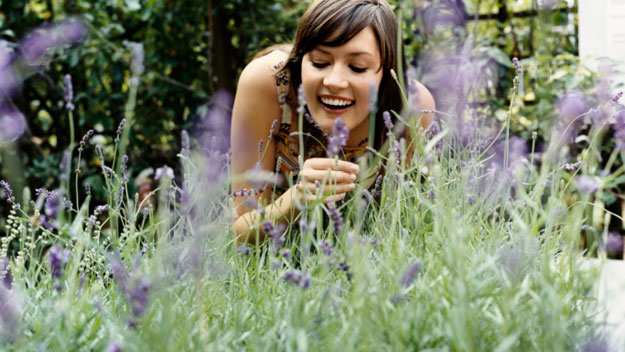Once upon a time lavender was supposed to be the sexiest of scents. Sheets and underclothes were stored with lavender to keep the moths away, and we all know what happens among the sheets.
And then Queen Victoria fell in love with lavender oil. She ordered that every room be polished with lavender and beeswax, so that the scent was with her whenever she — and her young husband, Albert — were indoors.
Nothing connected with the Queen could be sexy, so lavender became respectable again.
Sexy or not, lavender is one of the world’s good scents. There are at least 20 species of lavender bushes, all fragrant, and with a wide range of flowering and growing habits. There is a lavender for every area and every climate, as long as you give them a little care.
Keep lavenders away from tall plants so that they have good air circulation and a full day of sun.
English lavender (L angustifolia) is perhaps the hardiest of lavenders, with deep purple flowers, intensely fragrant and often used for oil, small, pale grey, tough leaves, very stiff stems and always growing to less than a metre. It will grow in subtropical and tropical areas, but probably won’t flower unless it has a period of cold. There are many cultivars of English lavender — white-flowered var alba, pink var rosea , dwarf “hidcote” and richly fragrant, dark-purple flowered “munstead”.
French lavender (L dentata) is more heat tolerant than the English lavenders. French lavender is a sprawling, soft, green-grey bush with longer softer leaves than English lavender and laxer stems and flower spikes. The flowers are bluish purple on long stems and are borne in both winter and summer so that the bush can appear to flower constantly. While still sweetly scented, French lavender hasn’t the power and plenitude of the English lavender.
Italian or Spanish lavender (L stoechas) is about the same height as English lavender, but a more delicate bush, with grey green leaves, much smoother than the indented French lavender leaves, and striking, very dark purple, oblong/ovate flowers — a strikingly different shape from the more common long and gently rounded lavender flower spikes.
Allardii lavender (L allardii) is an incredibly vigorous, but rather coarse, grey-leaved lavender, summer flowering and very fast growing, with deeply indented grey leaves. This is the best lavender for dry sunny banks, or if you know you won’t be able to water it over summer.
Green lavender (L viridis, L stoechas var viridis) is less hardy than most lavenders, a small, soft, green-leafed plant with what appear to be green flowers — really only the bracts are green and the flowers are an insignificant white. It’s a curiosity plant, without the striking flowers, foliage or rich scent of most other lavenders.
Dutch lavender, spikenard, spike (L latifolia or L spica) has silver-grey, largish leaves and fat dark-purple flowers. The scent is not quite as clear as English lavender and, though often used for lavender oil, the quality isn’t quite as good with a hint of camphor and spice as well as lavender.
Other lavenders include the frost tender Canary Island lavender (L mulitifida subspecies canariensis) — one of the best lavenders for subtropical and tropical climates, lemon-scented lavender (L citriodora), L burmannii with camphor-scented leaves, the small, hairy woolly lavender (L lanata) and the frost-sensitive fern-leafed lavender (L multifida).
How to grow lots of lavender
First, choose the right lavender for your area — though hopefully your local nursery will do this for you and only sell the sort that will do best in your climate. You can’t depend on this, though; some nurseries are more rigorously careful with what they stock than others.
Give lavender full sun. In humid areas keep it away from massed garden beds, and grow it either on an airy slope or in an above-ground bed. Most importantly, lavender likes a limey soil, and most Australian soils are acidic. Give your lavender a dusting of lime once every year or two and it will be much hardier.
You can cut the plant back by about a third after flowering every year — that is, cut off the flowers, then cut each branch back by one third. This is also a good time to cut out about a third of the branches of mature bushes. Lavender can get “woody” (develop lots of thick wood that soon dies). A neglected lavender bush may live for three to 10 years. A well-pruned one will last for many decades.
Lavender will tolerate a little light shade, but full sun is really best. Just think of lavender growing down a sunny rocky hillside and you’ll realise what your bushes need to be happy in your garden.
Lavender pillow
This is a lovely pillow to help you sleep. Take a pillow slip or cushion cover, loosely fill with pieces of foam rubber, and an equal quantity of dried lavender flowers, tied up in small bunches. Sew up the side.
The scent should stay for about a year. After that “refresh” it by opening it up again and replacing the old lavender with new bunches.


